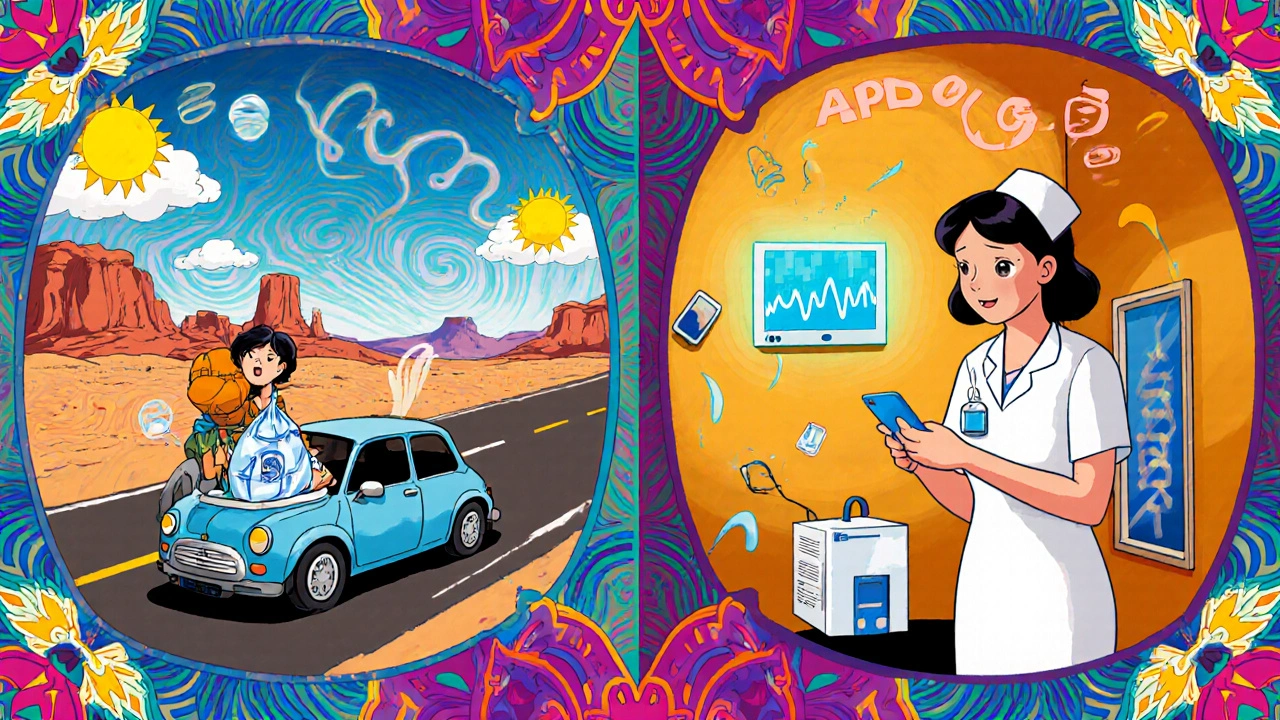Peritoneal Dialysis at Home: CAPD vs. APD - What You Need to Know
 Nov, 17 2025
Nov, 17 2025
When your kidneys fail, dialysis isn’t just a medical procedure-it becomes part of your daily life. For many people, doing dialysis at home is the best way to keep living like themselves. Two main types of peritoneal dialysis (PD) make this possible: CAPD and APD. They both use the lining of your belly as a filter, but how they work, what they require, and how they fit into your life are very different. Choosing between them isn’t about which is better overall-it’s about which one fits you.
How CAPD Works - Manual Exchanges, No Machine Needed
CAPD, or Continuous Ambulatory Peritoneal Dialysis, is the older, simpler version. You do the exchanges yourself, by hand, about 3 to 5 times a day. Each time, you connect a bag of dialysis fluid to a catheter in your abdomen. The fluid sits in your belly for 4 to 6 hours, pulling out waste and extra fluid, then you drain it out and replace it with fresh fluid. Each exchange takes about 30 to 40 minutes.
You don’t need electricity, a machine, or even a special room. All you need is a clean space-like a bathroom or kitchen-and a few bags of fluid. Most people do one exchange in the morning, one at lunch, one in the evening, and leave one overnight. You can walk around, work, or even drive between exchanges. That’s why many people who work, travel, or have active days prefer CAPD.
But there’s a catch. Every time you connect or disconnect the tubing, you risk letting germs in. That’s how peritonitis-an infection in the belly lining-happens. Studies show CAPD users have about 0.68 infections per year on average. That’s higher than APD. Training takes 10 to 14 days to get the sterile technique right. If your hands shake, you have arthritis, or you forget steps, it’s easy to mess up.
How APD Works - Sleep While the Machine Does the Work
APD, or Automated Peritoneal Dialysis, uses a machine called a cycler. You hook up to it at night before bed, and while you sleep, the machine automatically fills and drains your belly with fluid, usually 8 to 10 times over 8 to 10 hours. You wake up with your treatment done. No daytime exchanges. No carrying bags. Just a clean catheter and a quiet machine.
Modern cyclers-like the Baxter Amia or Fresenius Sleep-Safe-are smaller than a suitcase, weigh 15 to 25 pounds, and make about the same noise as a quiet library (35-45 decibels). They have safety features: sensors that stop the machine if there’s a leak, air bubble detectors, and even UV light to clean the lines. Many now connect to apps or remote monitoring systems so your care team can check your treatment data without you calling in.
Because the exchanges are done slowly and continuously overnight, fluid and toxin removal is more even. This leads to better blood pressure control and fewer hospital visits for fluid overload. A 2021 study found APD users had 22% fewer hypertension emergencies than CAPD users. Sleep quality also improves-people on APD get about 3.2 more hours of sleep per night on average than those doing daytime exchanges.
But APD isn’t foolproof. If the power goes out, the machine stops. If the tubing kinks, you might not notice until morning. About 12% of APD users have a cycler malfunction each year. And if you’re a light sleeper, even quiet noise can be annoying. Training takes longer-14 to 21 days-because you have to learn how to set up, troubleshoot, and care for the machine.
Costs and Insurance - What You’ll Actually Pay
Medicare covers 80% of home dialysis costs in the U.S., and most private insurers follow suit. But your out-of-pocket costs vary.
CAPD supplies-bags, tubing, cleaning kits-cost about $50 to $75 a month. No rental fees. No electricity bills for treatment. That makes it cheaper upfront. But if you get peritonitis often, your hospital bills can climb fast.
APD costs more monthly-$75 to $100-because you’re renting the cycler. Some programs charge a flat monthly fee, others bill per exchange. But here’s the twist: APD often leads to fewer hospital stays. Medicare data shows APD users have 18% fewer hospitalizations for fluid-related problems. That means less time off work, fewer emergency trips, and lower long-term costs.
Some states and programs now cover family members’ training as part of home dialysis support. That’s a big help if you need someone to help you set up the machine or handle emergencies.

Who Does Better on CAPD?
CAPD isn’t going away. It’s still the go-to for certain people.
- People over 75: Simpler, no machines to manage. Cognitive load is lower.
- Those with unstable electricity: Rural homes, apartments with old wiring, or areas prone to outages.
- Travelers: You can carry bags in a cooler. No need to ship a machine.
- People who dislike machines: Some just prefer doing things themselves.
A 2023 survey found 65% of CAPD users still work full-time. They schedule exchanges during breaks, lunch, or between meetings. One teacher in Ohio told me: “I do my exchange during planning period. No one even knows I’m on dialysis.”
But if you have shaky hands, trouble bending over, or memory issues, CAPD can become a burden. One patient in Florida switched to APD after three peritonitis episodes in a year-each one caused by a small mistake during a manual exchange.
Who Does Better on APD?
APD is growing fast-and for good reason.
- Working adults: 52% of APD users are between 18 and 64. You work during the day, sleep at night. Treatment doesn’t interfere.
- People with sleep issues: If you’re tired of being woken up for daytime exchanges, APD gives you back your nights.
- Those with high blood pressure or fluid overload: APD gives smoother, gentler fluid removal.
- People with caregivers: A spouse or family member can help set up the machine at night.
One ER nurse in Texas, who does APD, says: “I work 12-hour shifts three days a week. The cycler runs while I sleep. I don’t think about dialysis until I unhook in the morning.”
But APD isn’t for everyone. If you live in a small apartment, don’t have a quiet bedroom, or can’t plug in a machine safely, it’s not practical. And if you’re not tech-savvy, the learning curve can feel overwhelming.

Real-World Trade-Offs - What Patients Actually Say
Look at what real users say on patient forums.
CAPD users love freedom: “I can go on a road trip and do exchanges in a rest stop bathroom.” But they hate interruptions: “I can’t just sit and watch TV-I have to stop every 4 hours.”
APD users love sleep: “I feel like I’m living again.” But they hate breakdowns: “I had a cycler fail at 2 a.m. I had to do a manual exchange while panicking.”
A 2022 survey of 1,200 home dialysis patients found:
- CAPD: 78% rated travel flexibility as excellent; 63% said daytime exchanges ruined their routine.
- APD: 85% rated nighttime treatment as life-changing; 52% said machine noise or malfunctions were a problem.
Neither side is perfect. But the data shows APD users report 18% higher quality-of-life scores on standardized surveys. That’s not just about sleep-it’s about feeling in control, not interrupted.
What Your Doctor Should Check Before You Decide
It’s not just about preference. Your doctor needs to look at more than just your kidneys.
- Manual dexterity: Can you handle small tubing, screw caps, and clean surfaces? If you have arthritis or tremors, APD might be safer.
- Home setup: Do you have a clean, dry space for supplies? Can you plug in a machine safely? Is your bedroom quiet enough?
- Support system: Do you live alone? Is there someone who can help if the machine fails or you get sick?
- Residual kidney function: If you still make some urine, CAPD’s constant filtering may work better.
- Technology comfort: Can you learn to use a tablet or app for remote monitoring? If not, CAPD might be easier.
And don’t forget: training matters. You won’t be ready after one visit. Both modalities need weeks of practice, with nurses watching you do exchanges. If your clinic doesn’t offer both options, ask why. The American Society of Nephrology says 68% of clinics now offer both-so you should have a choice.
The Future: What’s Coming Next
APD is getting smarter. Baxter’s Amia system, launched in 2021, uses AI to adjust your fluid removal based on your weight and blood pressure each day. In trials, it cut fluid overload events by 31%. New models expected in 2025 will connect directly to your smartphone-reducing setup errors by 40%.
Meanwhile, CAPD is getting a boost too. New sterile connection systems are reducing infection rates. Some clinics now offer wearable PD devices in trials-tiny pumps you wear on your belt that do slow exchanges all day, without a machine.
But for now, the choice stays simple: CAPD for simplicity and freedom. APD for consistency and sleep. Your kidneys don’t care which one you pick. But your life does.
Can I switch from CAPD to APD later if I change my mind?
Yes, many people switch. If you find CAPD too disruptive or you develop frequent infections, switching to APD is common and safe. Your care team will help you transition-usually over a few weeks. The catheter stays in place, so no new surgery is needed. The same goes for switching from APD to CAPD if you lose power often or can’t handle the machine.
Is one method safer than the other?
Both are safe when done correctly. CAPD has a slightly higher risk of peritonitis because of manual handling-about 0.68 infections per year versus 0.52 for APD. APD has a small risk of machine failure or tubing issues, but modern cyclers have multiple safety features that reduce human error. Neither is risk-free, but APD’s automated process lowers the chance of mistakes during exchanges.
Do I need to stay home all day if I’m on APD?
No. APD runs at night while you sleep. During the day, you’re completely free. You can work, exercise, travel, or go out to lunch. You only need to be home for about 10 minutes in the morning to disconnect and store the machine. Some people even travel with their cyclers-there are portable battery packs available for emergencies.
Can I do CAPD if I live in a small apartment?
Yes. CAPD doesn’t need a machine, so you don’t need extra space. You just need a clean surface for your supplies and a place to store your dialysis bags-like a closet shelf or under the sink. No electrical outlets required. That’s why CAPD is often recommended for people in small homes or apartments.
What if I can’t afford the APD machine rental?
Most insurance plans, including Medicare, cover cycler rentals. If you’re worried about costs, ask your social worker about patient assistance programs. Some manufacturers offer rental subsidies or payment plans. CAPD may be cheaper upfront, but if APD reduces your hospital visits, it could save you money long-term. Don’t assume you can’t afford it-ask for help.
Sameer Tawde
November 18, 2025 AT 16:35CAPD lets you live, not just survive. I’ve seen guys in rural India do it with a bucket and a clean towel-no fancy machines needed. If you’ve got grit, you’ve got options.
Jeff Hakojarvi
November 20, 2025 AT 12:49Just wanna say thanks for laying this out so clear. I’m a nurse and I’ve seen too many patients get pushed into APD because it’s ‘easier’ for the clinic-but if someone’s got shaky hands or lives off-grid, CAPD is the real MVP. Don’t let anyone rush you.
Timothy Uchechukwu
November 21, 2025 AT 23:57Who even needs machines anymore anyway. Back in my day we used rocks and prayer. Now everyone’s scared of a little dirt and a 30 minute break. This whole thing is just corporate medicine selling fear
Ancel Fortuin
November 22, 2025 AT 16:04APD machines are being used to track your sleep patterns and sell your data to Big Pharma. You think they care about your kidneys? Nah. They want your biometrics. That ‘UV cleaning’? It’s a backdoor. I know a guy who had his insulin pump hacked. Same thing.
Samkelo Bodwana
November 23, 2025 AT 01:25I’ve been on CAPD for 7 years and switched to APD last year after my third peritonitis episode. It’s not about which is ‘better’-it’s about which version of your life you want to preserve. CAPD gave me freedom to travel and work odd hours, but APD gave me back my sleep, my peace, and my ability to actually enjoy Sunday mornings with my kids. Neither is perfect. Both are life-changing. The real win is having the choice at all. If your clinic doesn’t offer both, push harder. You deserve that.
Angela J
November 23, 2025 AT 22:53Wait… so the machine connects to your phone? That means they can turn it off remotely, right? Like… what if they decide you’re not ‘compliant’? I read about this in a forum-people’s cyclers just stopped working after a Medicare audit. Are we being watched?!
Sarbjit Singh
November 24, 2025 AT 12:20My uncle did CAPD for 5 yrs in Punjab, carried bags in a cooler box, did exchanges in the temple courtyard 😅 No power? No problem. But when he got tremors, switched to APD and now he sleeps like a baby. Tech ain’t evil-it’s just another tool. 🙏
Jonathan Gabriel
November 25, 2025 AT 20:22It’s funny how we treat dialysis like a tech choice when it’s really a philosophy choice. CAPD is the Zen monk-present, manual, interruptive, demanding discipline. APD is the Silicon Valley solution-automated, efficient, optimized for productivity. One asks you to slow down. The other asks you to outsource your body’s labor. Neither is morally superior. But if you’re trying to be a ‘productive citizen’ in a capitalist system, APD wins. If you’re trying to reclaim your humanity? CAPD wins. The real question isn’t ‘which machine?’ It’s ‘who do you want to be while you’re still alive?’